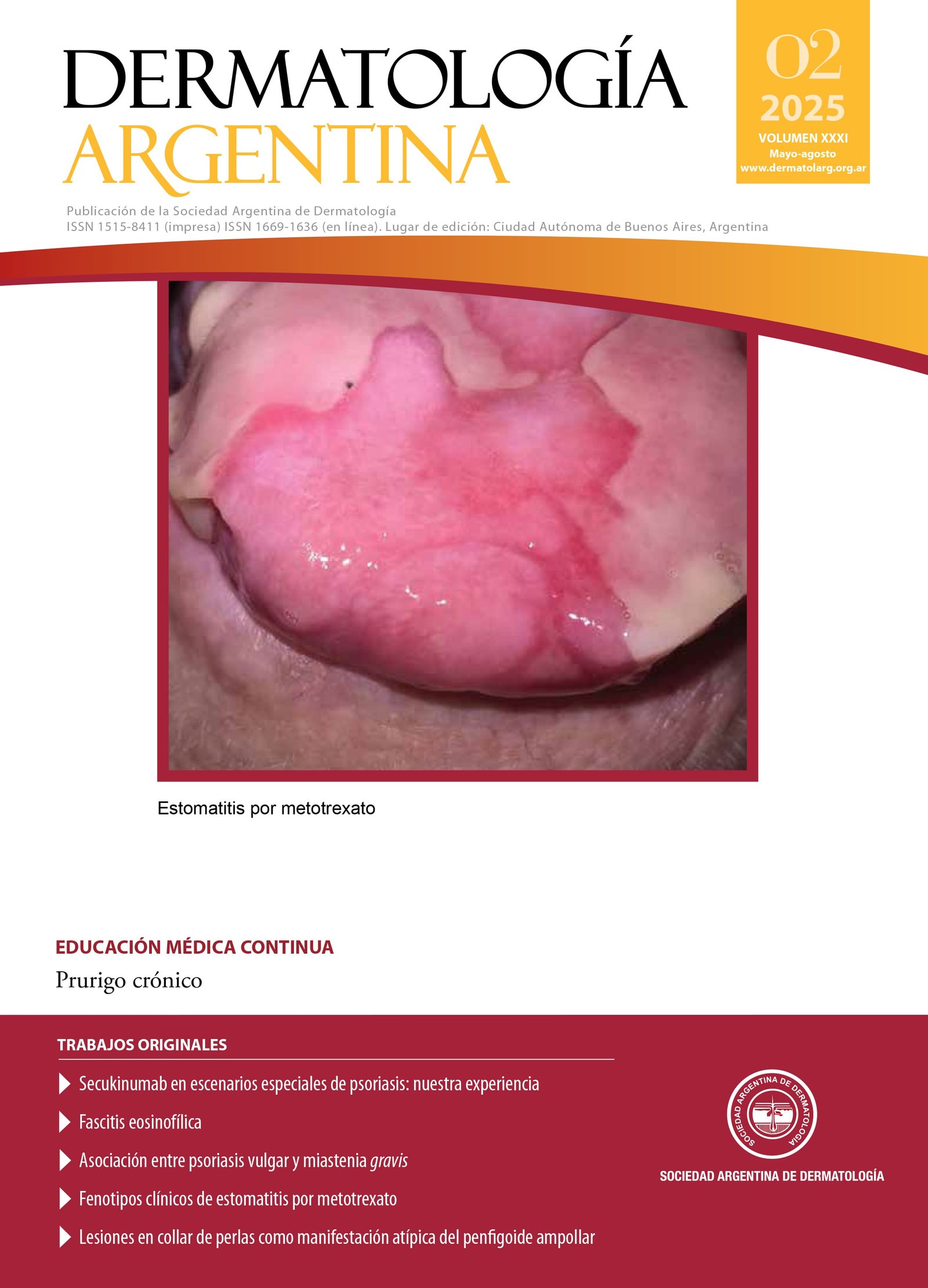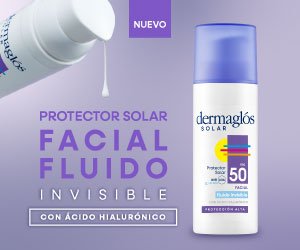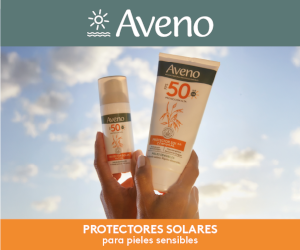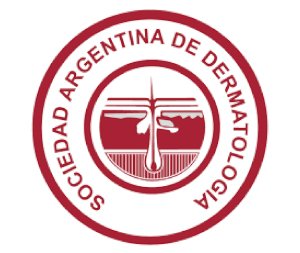Chronic prurigo
DOI:
https://doi.org/10.47196/da.v31i2.2861Keywords:
prurigo, etiology, clinical presentation, diagnosisAbstract
Prurigo is an inflammatory skin disease characterized by multiple plaques, papules, or isolated nodules, associated with intense itching. It primarily affects middle-aged individuals and is often linked to underlying diseases. We refer to chronic prurigo when there is chronic itching and scratching lasting more than 6 weeks, accompanied by the development of pruritic lesions, either localized or generalized.
It is a complex condition with partially unknown pathophysiology. There are few efficient therapies available, and it also carries a significant economic burden, requiring more consultations than other skin diseases. Moreover, it has a high negative impact on the patient's quality of life, for so a better understanding of this condition would benefit the patients. This work focuses on the definition, classification, diagnosis, and treatment of this entity.
References
I. Criado PR, Ianhez M, Criado RFJ, Nakano J, et ál. Prurigo: review of its pathogenesis, diagnosis, and treatment. An Bras Dermatol. 2024;99:706-720.
II. Ständer S, Pereira M, Berger T, Zeidler C, et ál. IFSI-guideline on chronic prurigo including prurigo nodularis. Itch. 2020;5:e42
III. Satoh T, Yokozeki H, Murota H, Tokura Y, et ál. Guidelines for the diagnosis and treatment of prurigo. J Dermatol. 2021; 48:e414-431.
IV. Iking A, Grudmann S, Chatzigerorgakidis E, Phan NQ, et ál. Prurigo as a symptom of atopic and non-atopic diseases: aetiology survey in a consecutive cohort of 108 patients. J Eur Acad Dermatol Venereol. 2013;27:550-557.
V. Pereira MP, Steinke S, Zeidler C, Forner C, et ál. European academy of dermatology and venereology European prurigo project: expert consensus on the definition, classification and terminology of chronic prurigo. J Eur Acad Dermatol Venereol. 2018;32:1059-1065.
VI. Monsel G, Ly F, Canestri A, Diousse P, et ál. Prevalence of skin disorders in HIV patients in Senegal and relationship to degree of immunosuppression. Ann Dermatol Venereol. 2008;135:187-193
VII. Morgan CL, Thomas M, Ständer S, Jabbar-Lopez ZK, et ál. Epidemiology of prurigo nodularis in England: a retrospective database analysis. Br J Dermato.l 2022;187:188-195.
VIII. Bahloul D, Hudson R, Balogh O, Mathias E, et ál. Prevalence, incidence and treatment patterns of prurigo nodularis in England. A retrospective database analysis. Br J Dermatol. 2024;4:207.
IX. Ryczek A, Reich A. Prevalence of prurigo nodularis in Poland. Acta Derm Venereol. 2020;100:adv00155.
X. Elmariah S, Kim B, Berger T, Chisolm S, et ál. Practical approaches for diagnosis and management of prurigo nodularis: United States expert panel consensus. J Am Acad Dermatol. 2021;84:747-760.
XI. Furue M, Yamazaki S, Jimbo K, Tsuchida T, et ál. Nationwide cross-sectional and seasonal multicenter study of dermatological patients in Japan. Jpn J Dermatol. 2009;119:1795-809.
XII. Furue M, Yamazaki S, Jimbow K, Tsuchida T, et ál. Prevalence of dermatological disorders in Japan: a nationwide, cross-sectional, seasonal, multicenter, hospital-based study. J Dermatol. 2011;38:310-20.
XIII. Boozalis E, Tang O, Patel S, Semenov YR, et ál. Ethnic differences and comorbidities of 909 prurigo nodularis patients. J Am Acad Dermatol. 2018;79:714-719
XIV. Docampo-Simón A, Sánchez-Pujol MJ, Silvestre-Salvador JF. Prurigo crónico: actualización. Actas Dermosifiliogr. 2022;113:563-574.
XV. Williams K. A, Huang A. H, Belzberg M, Kwatra S. G. Prurigo nodularis. J Am Acad Dermatol. 2020; 83:1567–1575.
XVI. Steinke S, Zeidler C, Riepe C, Bruland P, et ál. Humanistic burden of chronic pruritus in patients with inflammatory dermatoses. Results of the European Academy of Dermatology and Venereology Network on Assessment of Severity and Burden of Pruritus (PruNet) cross-sectional trial. J Am Acad Dermatol. 2018;79:457-463.e5.
XVII. Brenaut E, Halvorsen JA, Dalgard FJ, et ál. The self-assessed psychological comorbidities of prurigo in European patients: a multicentre study in 13 countries. J Eur Acad Dermatol Venereol. 2019;33:157-162
XVIII. Huang AH, Canner JK, Khanna R, Kang S, Kwatra SG. Real-world prevalence of prurigo nodularis and burden of associated diseases. J Invest Dermatol. 2020;140:480-483.e4.
XIX. Whang KA, Le TK, Khanna R, Williams KA, et ál. Health-related quality of life and economic burden of prurigo nodularis. J Am Acad Dermatol. 2022;86:573-580.
XX. Labib A, Ju T, Vander-Does A, Yosipovitch G. Immunotargets and therapy for prurigo nodularis. Immunotargets Ther. 2022;11:11-21.
XXI. Williams KA, Huang AH, Belzberg M, Kwatra SG. Prurigo nodularis: pathogenesis and management. J Am Acad Dermatol. 2020;83:1567-1575.
XXII. Murota H, Kitaba S, Tani M, Kaneda M, et ál. Assessments of labor productivity in skin disease patients with pruritus and investigations of improvement effects through histamine H1 antagonists. Prog Med. 2009;29:1842-1848
XXIII. Hanumaiah B, Joseph JM. Role of dermoscopy in the diagnosis of hypertrophic lichen planus and prurigo nodularis. Indian J Dermatol. 2019;64:341-345.
XXIV. Metz M, Zeidler C, Hawro T, Pereira M, et ál. Development and validation of a patient-reported outcome measure to assess disease control in chronic prurigo. JAMA Dermatol. 2024;160:187-193.
Downloads
Published
Issue
Section
License
Copyright (c) 2025 on behalf of the authors. Reproduction rights: Argentine Society of Dermatology

This work is licensed under a Creative Commons Attribution-NonCommercial-NoDerivatives 4.0 International License.
El/los autor/es tranfieren todos los derechos de autor del manuscrito arriba mencionado a Dermatología Argentina en el caso de que el trabajo sea publicado. El/los autor/es declaran que el artículo es original, que no infringe ningún derecho de propiedad intelectual u otros derechos de terceros, que no se encuentra bajo consideración de otra revista y que no ha sido previamente publicado.
Le solicitamos haga click aquí para imprimir, firmar y enviar por correo postal la transferencia de los derechos de autor













